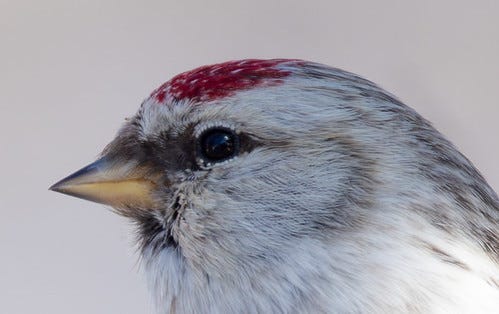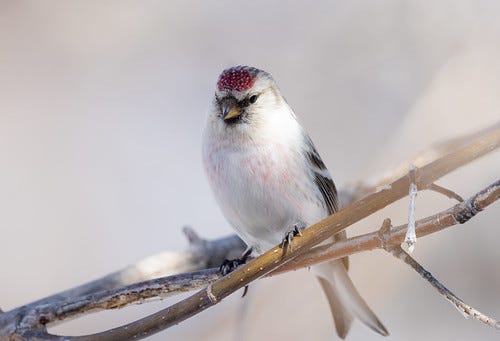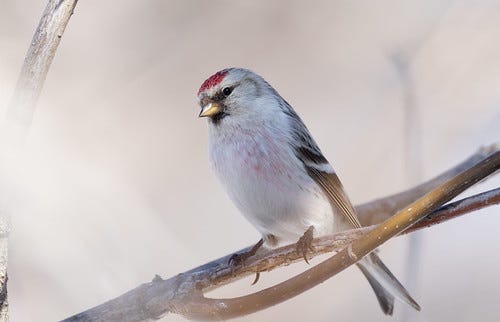(Listen to the radio version here when I record it Wednesday morning.)
When I did my Big Year in 2013, the very first bird I saw on New Year’s Day was a Hoary Redpoll—an auspicious sign! I was just looking out the back window when I saw it so didn’t even try to photograph it, but a little while later I did have my camera along when I went to my friend Pat Thomas’s house, where the first bird I happened to focus on was also a Hoary Redpoll.
The Hoary Redpoll is a lovely species, slightly larger than its close relative the Common Redpoll, with a slightly shorter bill. Both species have a sparkling ruby forehead. Other than that, Common Redpolls vary widely, some males with intensely red breasts, some females very drab.
Hoary Redpolls are also pretty variable, but the breasts of males are more pinkish than red. And unlike Common Redpolls, Hoaries have unstreaked rumps and undertail coverts.

Both redpolls breed above the treeline in the Arctic, but as if to affirm that the Hoary Redpoll ranges even further north than the Common Redpoll, its paler plumage has a cool frostiness.
Both species survive shockingly cold temperatures. One laboratory scientist found that Common Redpolls survive down to –65º F and Hoary Redpolls all the way down to –88º F, both clinging to life long after other songbirds, including ravens, succumbed (a measure of both warm-bloodedness and cold-bloodedness). Some Hoary Redpolls remain above the Arctic Circle in winter, but how they survive not just the frigid temperatures but also the endless nights, when they must find food in the dark, is not at all understood. Both redpolls visit feeders earlier in the morning and later at dusk than other songbirds—extra rod cells in their retinas allow them to see at lower light levels.
Fortunately for birders, some Hoary Redpolls do work their way south in winter, seeming to follow the same 2-year irruption cycle as Common Redpolls, and they usually hang out in sociable flocks with them, though virtually everywhere in the Lower–48, Common Redpolls vastly outnumber them.
I saw my lifer Common Redpoll at the Fenner Arboretum in Lansing, Michigan, on February 4, 1976. It was #123 on my life list.
Almost exactly two years later, on February 5, 1978, I saw my lifer Hoary Redpoll on a Wisconsin Society for Ornithology field trip to the Necedah National Wildlife Refuge. Ace Wisconsin birder Daryl Tessen spotted it at a distance—way further than I’d have been able to figure it out on my own. Fortunately, it came close enough for me to appreciate how it was not just paler than the redpolls around it but had no streaks on its rump or undertail coverts.

That first Hoary Redpoll experience is what got me into the habit of scrutinizing every redpoll in a flock trying to pick out outliers—a habit that is, for me, much more rewarding than scrutinizing, say, every winter gull trying to pick out a rarity. I’m sure many of my year lists would have benefitted had I focused more on gulls, but I get way more pleasure studying individual Common Redpolls, who are all adorable and wonderfully varied.
I saw my first Hoary Redpoll for my yard list on January 26, 1982, during the first winter we lived on Peabody Street. Even though redpolls are considered to have a 2-year irruption cycle, they show up virtually every winter here in northern Minnesota. Even during this exceptionally mild and mostly snow-free winter, Erik Bruhnke and I spotted a Common Redpoll in the Sax-Zim Bog on January 3.
I hadn’t seen any redpolls in my yard this year until our blizzard last week—now I’m seeing hundreds every day. I picked out at least one Hoary among them starting on Wednesday, and two on Friday and Saturday. I managed to photograph one through my closed office window on Saturday.
On Sunday, I got some of the best Hoary Redpoll photos I’ve ever taken in my life, at eye level through my open home office window. That sweet little bird showed off every field mark from every angle.
Some people are shocked that I get so many redpolls, but it’s simply a matter of providing a lot of food in multiple places. I have two tray feeders and my home-office window feeder.

Birds knock a lot of seed out of them, so redpolls gather beneath as well as on the feeders, and also wherever I scatter nyjer on the snow. Based on what’s left each day, they’re gobbling up everything I put out.
I had so few birds through most of the winter that I didn’t feed much sunflower this year, leaving me hardly any old seeds and shells to deal with. What is out there now is fresh, and soon warming temperatures, rain, and newly emerging grass will push any leftovers into the soil.
Nyjer is expensive—Russ paid $2 a pound for a 16-pound bag at our hardware store last week—and I’ve been going through more than a pound a day, so this would be like throwing money on the snow except that redpolls would never ever come to any yard for money. After a long winter devoid of snow and most birds, I’m so glad these chattery little sprites are here. Spending time with them is worth every penny.
April is just about always the biggest month for redpolls at feeders here. Wherever they spent the bulk of the winter, they seem to pass through Duluth as natural food resources dwindle before new spring growth begins. But the boom is quickly followed by the bust—just days after I see my biggest numbers of the year, I’ll be lucky to see one or two. Hoary Redpolls always seem to be among the first to depart, so day-by-day, April sightings of them grow increasingly precious.
Many taxonomists believe that a whole panoply of differences between Hoary and Common Redpolls—their arrival and departure dates on their breeding grounds; relative abundance from year to year; breeding habitats; and diets, physiology, behavior, size, and appearance—indicate that they truly are two separate species. But taxonomists focused on DNA believe that America’s two redpolls and the Lesser Redpoll of Europe are a single species, too similar genetically to differentiate.
Just about every year when the American Ornithological Society reviews proposals for changes in its Checklist, someone proposes, based on yet another new study, lumping the redpolls into a single species. It’s always fun for me to get an extra year bird when I spot my first Hoary Redpoll of the year—I’ll lose that if they lump them with the Common Redpoll. But whatever taxonomists call them, my heart will always leap the moment I spot any of these lovely northern birds.















